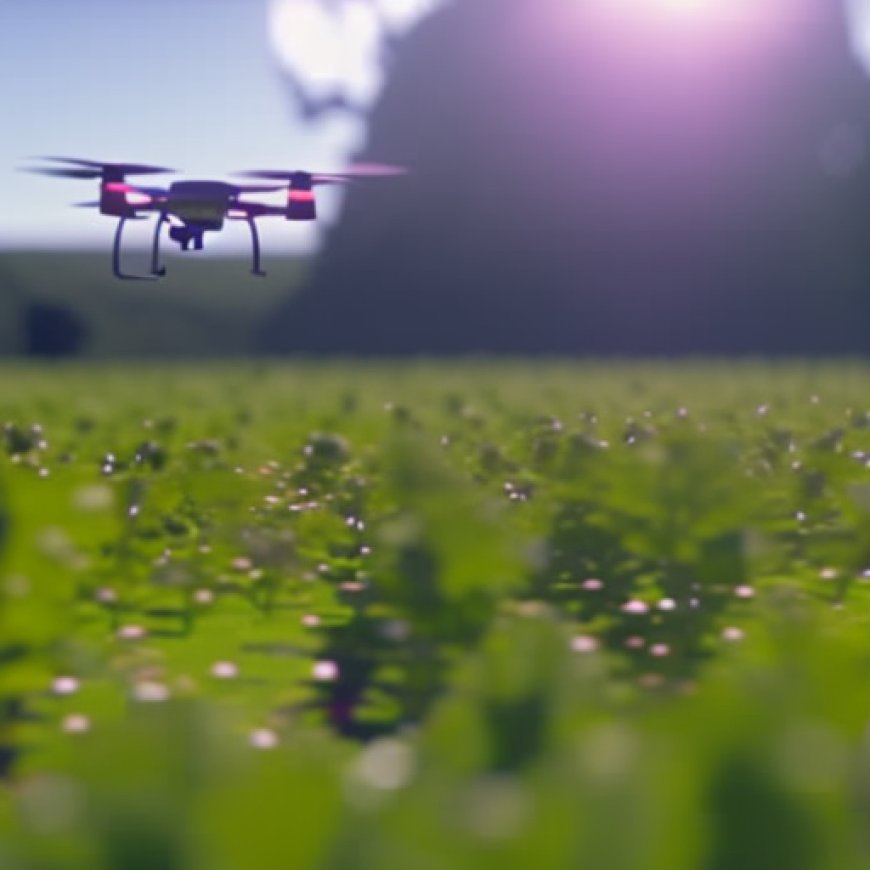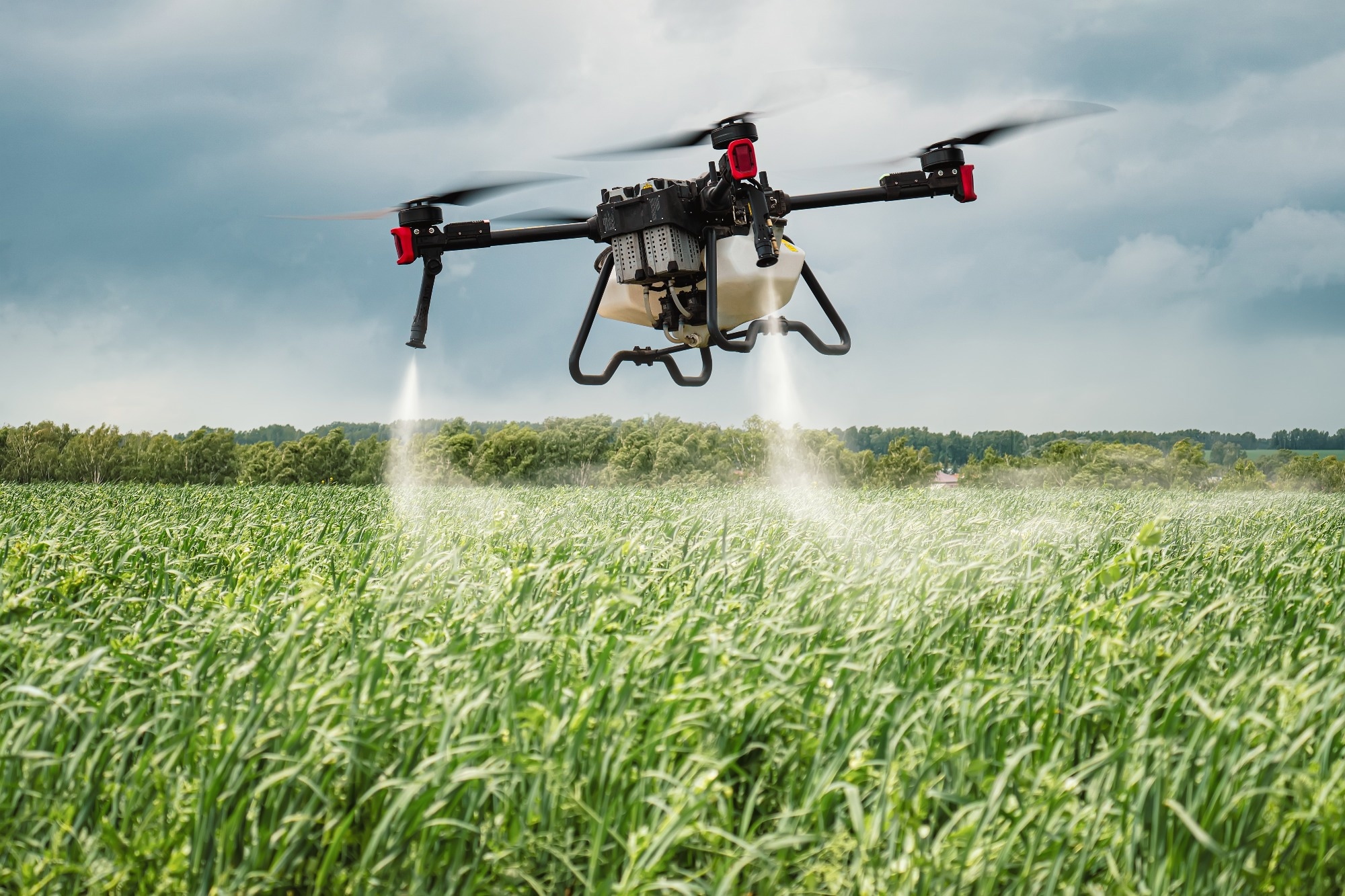Advancing Agriculture Drone Control with Hybrid Fuzzy PID Controllers
Advancing Agriculture Drone Control: Hybrid Fuzzy PID Controllers AZoRobotics


In an article recently published in the journal Applied Sciences, researchers proposed a hybrid fuzzy proportional-integral-derivative (PID) controller for quadcopter drones used in agriculture systems. They showcased the effectiveness of fuzzy PID controllers compared to the classically tuned PID controllers for smart agriculture systems.

Background
- Unmanned aerial vehicles (UAVs), commonly referred to as drones, are revolutionizing various industries, particularly agriculture, due to their versatility and efficiency. Drones, equipped with sensors and cameras, can autonomously or remotely perform tasks like crop monitoring, spraying, mapping, and harvesting with precision. Their benefits include lower costs, faster operation, wider coverage, and reduced environmental impact compared to traditional methods.
- Real-time data collection and processing capabilities empower farmers to make informed decisions and enhance operational efficiency. However, navigating drones in complex environments poses challenges, necessitating advanced controllers for stability, accuracy, robustness, and safety.
- To overcome these challenges, drones need effective controllers that can adjust their states (such as roll, pitch, yaw, altitude, and speed) according to the desired values and external disturbances. One of the most common controllers used in drones is the PID controller, which calculates the error between the desired and actual states and applies a correction based on three terms: proportional, integral, and derivative.
- PID controllers are simple, easy to implement, and widely used, but they also have some limitations, such as sensitivity to noise and measurement errors, difficulty in tuning the parameters, and poor performance in nonlinear and uncertain systems.
About the Research
The paper presented a hybrid fuzzy PID controller tailored to enhance the functionality of agricultural drones, addressing the shortcomings of conventional PID controllers by integrating fuzzy logic. This novel controller combined the robust control mechanisms of classical PID controllers with the adaptability of fuzzy logic controllers.
Fuzzy logic controllers use fuzzy sets and rules to effectively manage imprecise and ambiguous data, enabling decisions that mimic human reasoning. These controllers excel in adapting to environmental changes and uncertainties without the need for exact mathematical models of the systems they control.
The study examined a quadcopter drone system equipped with four rotors, which enabled it to perform complex maneuvers, including hovering, moving, and rotating in three-dimensional space. The drone’s components included the body frame, propellers, motors, and an array of sensors such as gyroscopes, accelerometers, magnetometers, barometers, and GPS. These sensors monitored various parameters like roll, pitch, yaw, altitude, and speed.
The controller processed this sensor data along with user inputs to align the drone’s actual state with its intended trajectory, adjusting motor speeds and propeller thrust accordingly. This dynamic response facilitated precise control over the drone’s movement to achieve specific mission objectives.
Using the Simulink/MATLAB platform, the researchers simulated the drone system and its control algorithms. They developed specific hybrid fuzzy PID controllers for managing roll, altitude, and speed. Each controller consisted of a fuzzy logic controller and a PID controller, where the fuzzy logic component dynamically tuned the PID parameters based on current errors and their rates of change. This included three inputs: error, error change, and PID output, and generated a correction factor to modify the PID controller’s output.
The fuzzy logic component utilized five fuzzy sets (negative big, negative small, zero, positive small, and positive big) for each input and output, applying 125 rules to define their interrelations. It used the Mamdani method for fuzzy inference and the centroid method for defuzzification.
Additionally, the study compared the performance of the hybrid fuzzy PID controller with traditional PID controllers, evaluating metrics such as response time, overshoot, settling time, and steady-state error. Tests were conducted under various input conditions, including step, ramp, sinusoidal, and disturbance inputs, to assess adaptability and effectiveness.
Research Findings
The outcomes showed that the new controller consistently outperformed classically tuned PID controllers across all scenarios and states. It exhibited superior performance by delivering faster, smoother, and more accurate responses compared to conventional PID controllers.
Additionally, it demonstrated enhanced robustness and adaptability to system changes and uncertainties. The researchers observed significant improvements in the quadcopter system’s performance, with enhancements of 41.5 %, 11 %, and 44 % for roll, altitude, and speed, respectively, over classically tuned PID controllers.
The paper has significant implications across various domains, especially in smart agriculture. The hybrid fuzzy PID controllers can enhance the stability, precision, and efficiency of quadcopter drones used in agricultural tasks such as crop monitoring, spraying, mapping, and harvesting. These improvements could lead to more effective and sustainable agricultural practices, optimizing resource use and increasing crop yields.
Moreover, the controllers can also enhance the safety and reliability of drones, mitigating the risks of accidents and damages. Furthermore, the application extends beyond agriculture to other drone types, UAVs, and systems requiring precise and robust control, including robotics, aerospace, and industrial automation.
Conclusion
To sum up, the research presented a novel and effective approach for controlling quadcopter drones in smart agriculture systems using hybrid fuzzy PID controllers. This method has the potential to significantly enhance the performance of the quadcopter system in terms of response time, overshoot, settling time, and steady-state error. Furthermore, the study demonstrated that the hybrid fuzzy PID controllers can adapt to changing and uncertain environments, providing stable and accurate responses.
Moving forward, the researchers acknowledged limitations and proposed future directions. They suggested optimizing fuzzy rules and parameters, integrating additional controllers and sensors, and conducting real-world testing to further investigate and enhance performance. These steps could contribute to advancing the application of hybrid fuzzy PID controllers in practical agricultural drone systems and beyond.
Journal Reference
-
SDGs, Targets, and Indicators
-
SDG 2: Zero Hunger
- Target 2.4: By 2030, ensure sustainable food production systems and implement resilient agricultural practices that increase productivity and production, that help maintain ecosystems, that strengthen capacity for adaptation to climate change, extreme weather, drought, flooding and other disasters, and that progressively improve land and soil quality.
- Indicator 2.4.1: Proportion of agricultural area under productive and sustainable agriculture.
- Indicator 2.4.2: Average income of small-scale food producers, by sex and indigenous status.
-
SDG 9: Industry, Innovation, and Infrastructure
- Target 9.5: Enhance scientific research, upgrade the technological capabilities of industrial sectors in all countries, in particular developing countries, including, by 2030, encouraging innovation and substantially increasing the number of research and development workers per 1 million people and public and private research and development spending.
- Indicator 9.5.1: Research and development expenditure as a proportion of GDP.
-
SDG 12: Responsible Consumption and Production
- Target 12.2: By 2030, achieve the sustainable management and efficient use of natural resources.
- Indicator 12.2.1: Material footprint, material footprint per capita, and material footprint per GDP.
- Indicator 12.2.2: Domestic material consumption, domestic material consumption per capita, and domestic material consumption per GDP.
Table: SDGs, Targets, and Indicators
SDGs Targets Indicators SDG 2: Zero Hunger Target 2.4: By 2030, ensure sustainable food production systems and implement resilient agricultural practices that increase productivity and production, that help maintain ecosystems, that strengthen capacity for adaptation to climate change, extreme weather, drought, flooding and other disasters, and that progressively improve land and soil quality. Indicator 2.4.1: Proportion of agricultural area under productive and sustainable agriculture.
Indicator 2.4.2: Average income of small-scale food producers, by sex and indigenous status.SDG 9: Industry, Innovation, and Infrastructure Target 9.5: Enhance scientific research, upgrade the technological capabilities of industrial sectors in all countries, in particular developing countries, including, by 2030, encouraging innovation and substantially increasing the number of research and development workers per 1 million people and public and private research and development spending. Indicator 9.5.1: Research and development expenditure as a proportion of GDP. SDG 12: Responsible Consumption and Production Target 12.2: By 2030, achieve the sustainable management and efficient use of natural resources. Indicator 12.2.1: Material footprint, material footprint per capita, and material footprint per GDP.
Indicator 12.2.2: Domestic material consumption, domestic material consumption per capita, and domestic material consumption per GDP.Analysis
The issues highlighted in the article are connected to the following Sustainable Development Goals (SDGs):
- SDG 2: Zero Hunger
- SDG 9: Industry, Innovation, and Infrastructure
- SDG 12: Responsible Consumption and Production
Based on the article’s content, the specific targets under these SDGs can be identified as:
- Target 2.4: By 2030, ensure sustainable food production systems and implement resilient agricultural practices that increase productivity and production, that help maintain ecosystems, that strengthen capacity for adaptation to climate change, extreme weather, drought, flooding and other disasters, and that progressively improve land and soil quality.
- Target 9.5: Enhance scientific research, upgrade the technological capabilities of industrial sectors in all countries, in particular developing countries, including, by 2030, encouraging innovation and substantially increasing the number of research and development workers per 1 million people and public and private research and development spending.
- Target 12.2: By 2030, achieve the sustainable management and efficient use of natural resources.
The article mentions or implies the following indicators that can be used to measure progress towards the identified targets:
- Indicator 2.4.1: Proportion of agricultural area under productive and sustainable agriculture
- Indicator 2.4.2: Average income of small-scale food producers, by sex and indigenous status
- Indicator 9.5.1: Research and development expenditure as a proportion of GDP
- Indicator 12.2.1: Material footprint, material footprint per capita, and material footprint per GDP
- Indicator 12.2.2: Domestic material consumption, domestic material consumption per capita, and domestic material consumption per GDP
The article discusses the use of hybrid fuzzy PID controllers for quadcopter drones in agriculture systems, which can enhance the stability, precision, and efficiency of agricultural tasks such as crop monitoring, spraying, mapping, and harvesting. These improvements contribute to achieving sustainable food production systems (Target 2.4) and enhancing the technological capabilities of the agriculture industry (Target 9.5). The indicators mentioned in the article, such as the proportion of agricultural area under productive and sustainable agriculture and average income of small-scale food producers, can be used to measure progress towards these targets.
The article also emphasizes the importance of sustainable management and efficient use of natural resources in agriculture systems. The hybrid fuzzy PID controllers can help optimize resource use and increase crop yields, contributing to the sustainable management of natural resources (Target 12.2). The indicators related to material footprint and domestic material consumption can be used to measure progress towards this target.
Copyright: Dive into this article, curated with care by SDG Investors Inc. Our advanced AI technology searches through vast amounts of data to spotlight how we are all moving forward with the Sustainable Development Goals. While we own the rights to this content, we invite you to share it to help spread knowledge and spark action on the SDGs.
Fuente: azorobotics.com

Join us, as fellow seekers of change, on a transformative journey at https://sdgtalks.ai/welcome, where you can become a member and actively contribute to shaping a brighter future.
-







